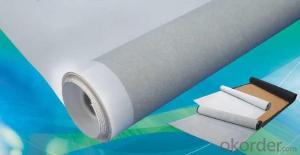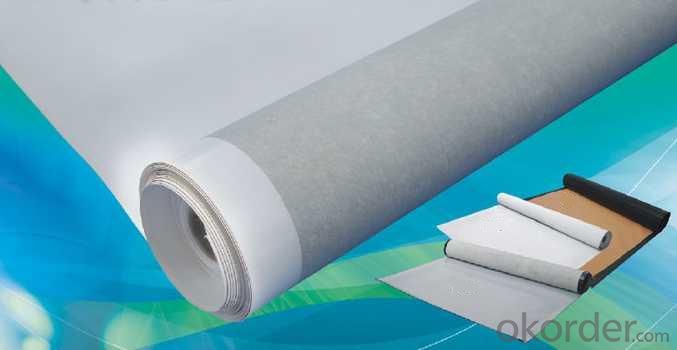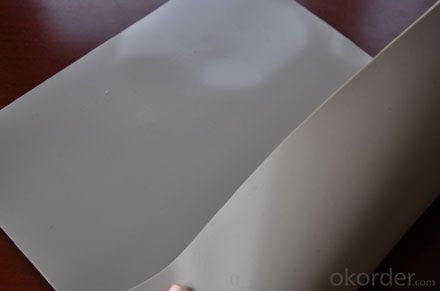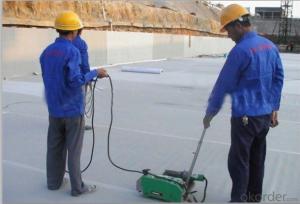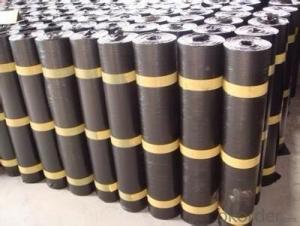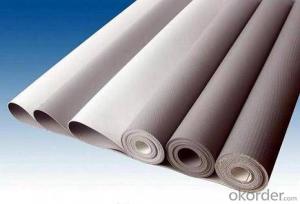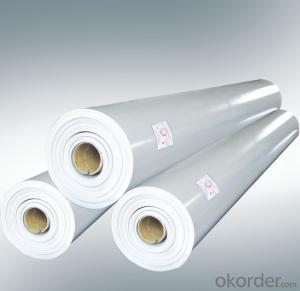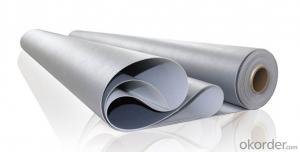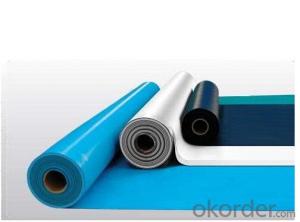Basement Reinforced PVC Waterproofing Membrane
- Loading Port:
- China main port
- Payment Terms:
- TT OR LC
- Min Order Qty:
- 5000 m²
- Supply Capability:
- 100000 m²/month
OKorder Service Pledge
OKorder Financial Service
You Might Also Like
Introduction
Polyvinyl Chloride (PVC) waterproof membrane is a new polymer waterproof membrane which is made from polyvinyl chloride resin, and mixed with plasticizer, filler, antioxygen, ultraviolet absorber and other auxiliaries.
Specification
No. | Item | L | N | W | ||||
I | II | I | II | I | II | |||
1 | Tensile strength N/cm ≥ | 100 | 160 | 8 | 12 | 100 | 160 | |
2 | fracture elongation %≥ | 150 | 200 | 200 | 200 | 150 | 200 | |
3 | Dimension Changing at heating %≤ | 1.5 | 1 | 3 | 2 | 1.5 | 1 | |
4 | Foldability at low temperature °C | -20 | -25 | -20 | -25 | -20 | -25 | |
5 | Water tightness | No leakage | No leakage | No Leakage | ||||
6 | Joint shear resistance (N/mm)≥ | 3 | 3 | 6 | ||||
7 | Thermal Ageing treatment | Appearance | no bubble | no bubble | no bubble | |||
Tensile strength changing rate % | ±25 | ±20 | ±25 | ±20 | ±25 | ±20 | ||
Breaking elongation changing rate% | ||||||||
8 | Chemical corrosion resistance | foldability at low temperature °C | -15 | -20 | -15 | -20 | -15 | -20 |
Tensile strength changing rate % | ±25 | ±20 | ±25 | ±20 | ±25 | ±20 | ||
Breaking elongation changing rate% | ||||||||
9 | Artificial climate accelerated aging | foldability at low temperature °C | -15 | -20 | -15 | -20 | -15 | -25 |
Tensile strength changing rate % | ±25 | ±20 | ±25 | ±20 | ±25 | ±20 | ||
Breaking elongation changing rate% | ||||||||
Applications
1) All kinds of roofs, such as steel structure roof, planted roof etc.
2) Underground engineering, such as building basement, subways, tunnels, air raid shelter, etc.
3) Other projects like artificial lake, dam, water reservoir, grain storehouse, etc.
Features
1. Good combination of high elasticity and tensile strength.
2. Fine resistance to static electricity.
3. Excellent resistance to ageing / weathering.
4. Durable, the effective age can be more than 20 years used on exposed surfaces, used on non-exposed surfaces, it can reach 50 years.
5. Fine flexibility at low temperature, adaptable to cold conditions.
6. Root-resistance can be used on the planting roofs.
7. Fine puncture resistance, joint peel strength and joint shear strength.
8. Fine UV-resistance, no pollution to environment.
9. Easily welding, installing, secure.
10. Easy treatments to the delicate parts of corners and edges.
11. Convenient maintenance with low cost.
RFQ
1. What is your MOQ?
--Our MOQ is 5000 m2
2. Can you provide sample?
--Yes, samples are in stock. we can offer free sample for you.
3. Do you offer OEM service?
--Yes, we can print customers’ logo on the packaging;
And the size and specification can be produced and design according to your demand.
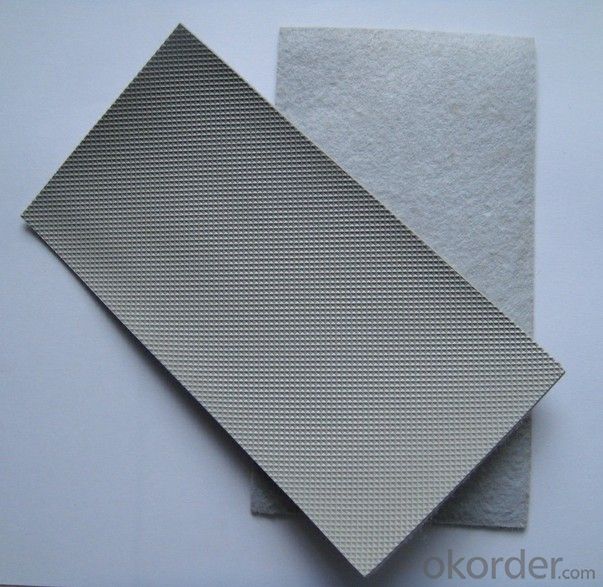
- Q: Can a waterproofing membrane be used for a green roof?
- Yes, a waterproofing membrane can be used for a green roof. A waterproofing membrane is an essential component of any green roof system as it helps to protect the underlying structure from water damage. It prevents water infiltration, which can cause structural damage and mold growth. Additionally, a waterproofing membrane helps to retain the necessary moisture within the green roof system, ensuring the plants have a consistent water supply. By using a waterproofing membrane, you can effectively create a sustainable and environmentally friendly green roof while also maintaining the integrity of the building structure.
- Q: Can a waterproofing membrane be used for laboratories or research centers?
- Yes, a waterproofing membrane can be used for laboratories or research centers. Waterproofing membranes are effective in preventing water infiltration and can help protect sensitive equipment, materials, and experiments from water damage. They can be applied to various surfaces such as floors, walls, and roofs to create a watertight barrier, ensuring a safe and dry environment for laboratory and research activities.
- Q: Can waterproofing membranes be used on swimming pool decks?
- Swimming pool decks can indeed benefit from the use of waterproofing membranes. These membranes are specifically designed to act as a barrier against water infiltration, making them an excellent solution for areas that are constantly exposed to water, such as swimming pool decks. By applying a waterproofing membrane to the surface of the deck, it effectively prevents any water from seeping through and causing harm to the underlying structure. Moreover, waterproofing membranes also offer protection against chemicals, UV rays, and general wear and tear, which are commonly encountered in swimming pool environments. All in all, incorporating waterproofing membranes on swimming pool decks can extend their lifespan, decrease maintenance expenses, and elevate the overall safety and appearance of the space.
- Q: Can a waterproofing membrane be used for water treatment plants?
- Yes, a waterproofing membrane can be used for water treatment plants. Waterproofing membranes are designed to prevent the passage of water and can be used to provide a barrier against water leakage in various structures, including water treatment plants. These membranes can be applied to different areas of the plant, such as tanks, reservoirs, pipes, and basements, to prevent water infiltration and protect the infrastructure from potential damage. Additionally, waterproofing membranes can help maintain the integrity of the water treatment process by ensuring that water remains contained within designated areas and does not seep into surrounding soil or structures.
- Q: Can a waterproofing membrane be used for potable water tanks?
- No, a waterproofing membrane should not be used for potable water tanks. While a waterproofing membrane is designed to prevent water penetration and protect surfaces from moisture damage, it is not suitable for ensuring the safety and purity of potable water. Potable water tanks require materials that are specifically designed and approved for water storage, such as food-grade coatings or liners. These materials are formulated to prevent any leaching or contamination of the water, ensuring its safety for consumption. Therefore, it is important to use the appropriate materials and follow industry standards and regulations when constructing potable water tanks.
- Q: What are the potential drawbacks or limitations of using a waterproofing membrane?
- Using a waterproofing membrane has the potential for a drawback if it is not installed properly. Incorrect installation can result in leaks and water damage. Proper application and sealing of the membrane require a certain level of expertise and attention to detail. Another limitation is that waterproofing membranes can be relatively expensive compared to other methods of waterproofing. The cost of purchasing and installing the membrane, as well as any necessary maintenance or repairs, can accumulate quickly. This may make it less feasible for individuals or organizations on a tight budget. Furthermore, waterproofing membranes are not a one-size-fits-all solution. Different types of membranes are suitable for different applications, and it is crucial to select the appropriate one based on the project's specific requirements. This can be challenging for individuals without experience in the field, as it requires knowledge and understanding of the available options. Another potential drawback is the limited lifespan of waterproofing membranes. Over time, they can deteriorate or become damaged, necessitating replacement or repairs. Fixing the issue may be costly and time-consuming, especially if the membrane needs to be removed and replaced. Finally, waterproofing membranes are primarily used for below-grade applications or on horizontal surfaces like roofs or decks. They may not be as effective for vertical surfaces such as walls or in areas with significant movement or stress, such as expansion joints. In such cases, alternative waterproofing methods may be more suitable. In conclusion, while waterproofing membranes provide excellent protection against water intrusion, they also have potential drawbacks and limitations, including improper installation, high cost, the need for expertise in selecting the right membrane, limited lifespan, and application limitations. It is important to consider these factors and explore alternative options before deciding on a waterproofing solution.
- Q: How does a waterproofing membrane handle freeze-thaw cycles?
- A waterproofing membrane is designed to withstand freeze-thaw cycles by having specific properties that enable it to expand and contract without compromising its integrity. Freeze-thaw cycles occur when water penetrates the membrane and freezes during colder temperatures, causing it to expand. As the ice melts during warmer temperatures, the membrane should have the ability to contract back to its original state. To handle freeze-thaw cycles, a waterproofing membrane typically possesses elasticity and flexibility, allowing it to accommodate the expansion and contraction without cracking or breaking. It may also have a low water absorption rate to prevent water from seeping into the membrane. Additionally, the membrane should have excellent adhesion to the substrate to ensure it remains in place during temperature fluctuations. Some waterproofing membranes incorporate special additives or technology to enhance their freeze-thaw resistance. These additives may include polymers or elastomers that improve the membrane's ability to withstand extreme temperature changes. Moreover, some membranes have reinforced layers or fabric inserts that provide additional strength and durability, helping them better handle freeze-thaw cycles. Overall, a well-designed waterproofing membrane should be able to handle freeze-thaw cycles effectively by being elastic, flexible, resistant to water absorption, and strongly adhered to the substrate. This ensures the membrane's longevity and prevents water infiltration, protecting structures from potential damage caused by freeze-thaw cycles.
- Q: Can a waterproofing membrane be used in historic buildings?
- Yes, a waterproofing membrane can be used in historic buildings. Historic buildings often face challenges related to moisture infiltration and water damage due to their age and construction materials. Waterproofing membranes are a common solution to prevent water seepage and protect the building's structural integrity. However, it is important to choose a waterproofing membrane that is compatible with the historic building's materials and construction methods to ensure its preservation and adherence to historical authenticity. Additionally, any waterproofing work done on a historic building should be carried out by professionals with expertise in historic preservation to ensure proper installation and minimal impact on the building's historical value.
- Q: Can waterproofing membranes be used on plant rooms?
- Indeed, plant rooms can benefit from the utilization of waterproofing membranes. Within these rooms, one can typically find various apparatus and machinery that necessitate safeguarding against potential water harm. By implementing waterproofing membranes, a formidable defense is established to impede water infiltration, averting leaks and potential destruction to both the plant room and its contents. Typically, these membranes are administered to the walls, floors, and roofs of the plant room to ensure comprehensive waterproofing. Moreover, in addition to their water resistance, these membranes possess the ability to shield against other elements such as chemicals and fluctuations in temperature, rendering them an optimal solution for plant rooms.
- Q: Are waterproofing membranes resistant to high temperatures?
- Yes, waterproofing membranes are typically designed to be resistant to high temperatures. They are made from materials such as modified bitumen, PVC, or EPDM that have excellent heat resistance properties, allowing them to withstand high temperatures without degrading or losing their waterproofing capabilities.
Send your message to us
Basement Reinforced PVC Waterproofing Membrane
- Loading Port:
- China main port
- Payment Terms:
- TT OR LC
- Min Order Qty:
- 5000 m²
- Supply Capability:
- 100000 m²/month
OKorder Service Pledge
OKorder Financial Service
Similar products
Hot products
Hot Searches
Related keywords
